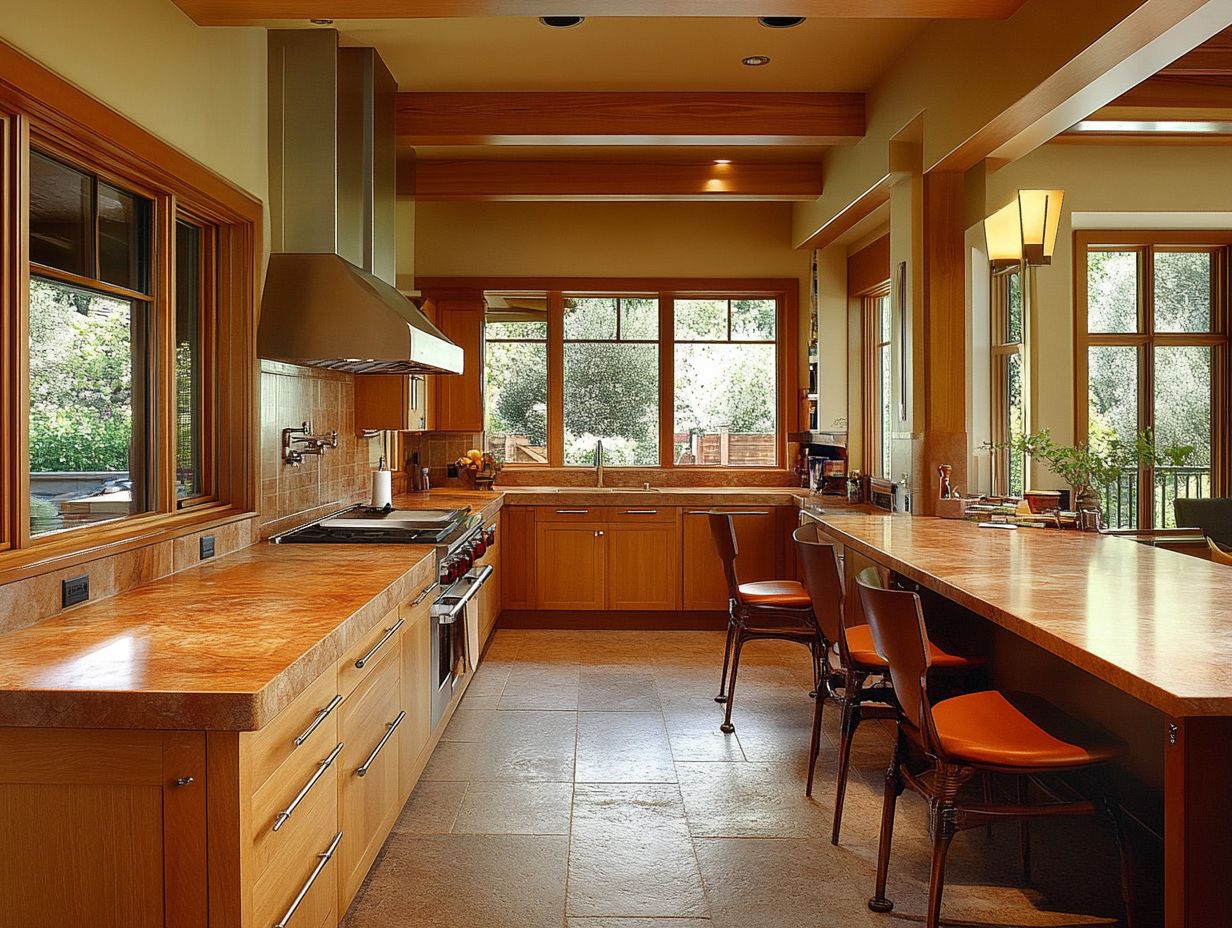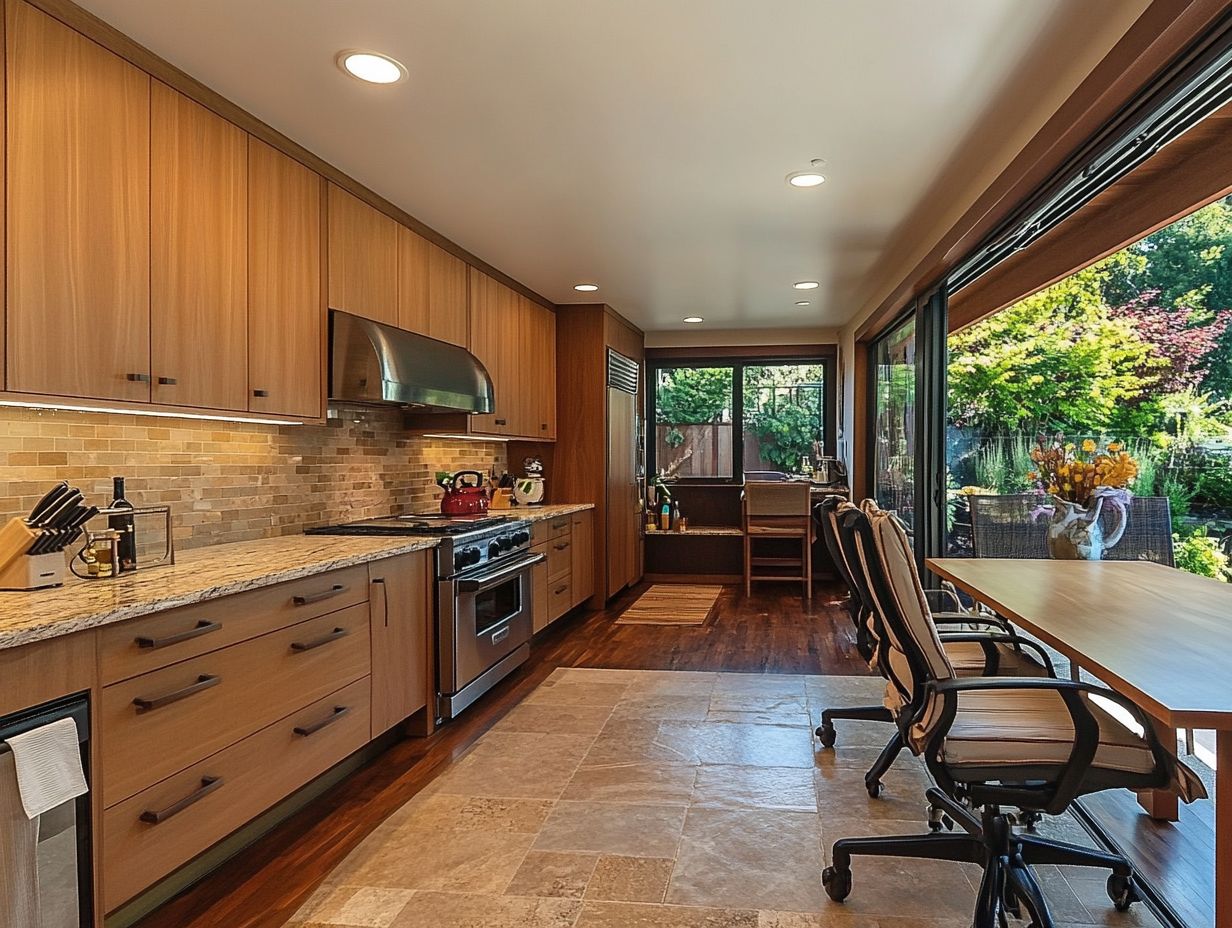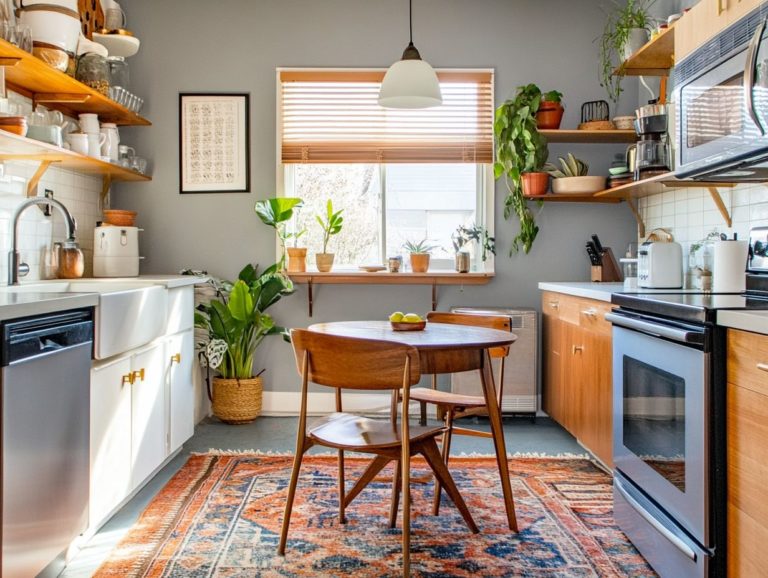How to Plan a Kitchen Layout for Aging in Place
Aging in place is an increasingly popular choice that empowers you to live comfortably and independently in your own home as you grow older. Let’s dive into why planning your kitchen is crucial!
This article highlights the importance of carefully planning a kitchen layout specifically designed for this lifestyle. You’ll discover essential design elements and accessible features that ensure your kitchen remains functional and safe for everyone, no matter their age or ability.
We will also explore budgeting and financing options to help you craft a space that truly meets your needs. Whether you’re embarking on a kitchen redesign or preparing for the future, this guide provides valuable insights to help you create the ideal environment for aging in place.
Contents
- Key Takeaways:
- Why Plan a Kitchen Layout for Aging in Place?
- Designing a Kitchen Layout for Aging in Place
- Accessible Features to Incorporate
- Creating a Safe and Functional Kitchen
- Tips for Making the Kitchen User-Friendly
- Cost Considerations for an Aging in Place Kitchen
- Budgeting and Financing Options
- Frequently Asked Questions
- What is aging in place and why is it important to consider when planning a kitchen layout?
- What are some key features to include in a kitchen layout for aging in place?
- How can I make my kitchen more accessible for individuals with mobility limitations?
- What are some safety considerations to keep in mind when planning a kitchen layout for aging in place?
- Should I consider adding technology to my kitchen for aging in place?
- Can I still have a stylish kitchen while adding features for aging in place?
Key Takeaways:

- A well-designed kitchen layout enhances safety, accessibility, and functionality for individuals wanting to stay in their homes as they age.
- Key elements include easy-to-reach storage, multiple work surfaces, and non-slip flooring.
- Incorporating features like adjustable countertops and pull-out shelves can make daily tasks easier for aging individuals and reduce the risk of accidents.
What is Aging in Place?
Aging in place means you can enjoy the comfort of your own home as you grow older, living independently and safely without the stress of moving to assisted living or nursing facilities. This concept highlights home modifications and design that works for everyone, regardless of age or ability, ensuring that your living environment is functional and adaptable to your lifestyle changes over time.
By integrating modifications like grab bars in bathrooms, wider doorways, and non-slip flooring, you can navigate your home with greater ease, significantly reducing the risk of falls and injuries. Universal design promotes spaces that everyone can use, contributing to a more inclusive environment.
Beyond these physical changes, aging in place nurtures emotional stability and connection. Imagine enjoying your favorite meals with loved ones in a space that feels just right—this is what aging in place can offer you! Being in familiar surroundings helps keep your social ties intact within your community, enhancing your quality of life.
Why Plan a Kitchen Layout for Aging in Place?
Planning a kitchen layout for aging in place is essential for ensuring the safety and well-being of older adults. Kitchens can harbor hazards that may lead to falls or injuries if not thoughtfully designed.
By incorporating accessible design principles, you can craft an environment that promotes fall prevention and facilitates daily tasks for seniors. This approach enhances their independence and enriches their quality of life.
Benefits and Considerations
Designing a kitchen for aging in place offers benefits that go beyond convenience; it enhances safety, accessibility, and independence for older adults. This thoughtful approach allows them to continue enjoying everyday cooking and social activities.
When considering kitchen safety features, fall prevention strategies, and the principles of universal design, you’re not just meeting functional needs—you’re supporting the emotional well-being of seniors.
A carefully designed kitchen can significantly reduce feelings of isolation, transforming it into a welcoming haven where friends and family can gather to share meals and culinary adventures. Features such as lower countertops, pull-out cabinets, and easily reachable appliances enable older adults to prepare meals independently, reducing physical strain.
Incorporating bright, well-placed lighting and non-slip flooring boosts safety and enhances confidence, enabling individuals to navigate their space effortlessly. Ultimately, a well-designed kitchen becomes a vibrant hub of interaction and joy, nurturing relationships and enriching quality of life during a pivotal phase of aging.
Designing a Kitchen Layout for Aging in Place

Designing a kitchen layout for aging in place requires a thoughtful strategy that emphasizes accessible design principles. This allows older adults to navigate their kitchens safely and easily.
Essential elements to consider include:
- Non-slip flooring to minimize fall risks
- Ample space for walking aids or wheelchairs
- Kitchen appliances arranged to enhance usability and accessibility
This approach fosters independence and creates an inviting, functional environment for all.
Key Elements to Include
When designing a kitchen layout for aging in place, consider including several essential elements that ensure functionality and safety. What makes a kitchen truly user-friendly?
Think about comfortable design, accessible cabinets, effective lighting solutions, and user-friendly kitchen appliances. By integrating these components, you can create a space that encourages independence while minimizing the risk of accidents.
Effective lighting enhances visibility, helping you navigate and identify ingredients or tools easily.
Accessibility in cabinets is also key; adjustable shelves or pull-out drawers can reduce strain for those with limited mobility, making it easier to reach essential items.
Ergonomic design elements, like counter heights suited for various tasks and cushioned flooring, elevate comfort levels, reducing fatigue during cooking and meal prep.
These considerations ensure a safe kitchen and transform it into a space where culinary creativity can flourish.
Accessible Features to Incorporate
Incorporating accessible features into your kitchen for aging in place is essential to reduce common hazards and ensure ease of use for older adults.
Consider integrating features such as pullout shelves, adaptable countertops, and thoughtfully positioned kitchen tools. These enhancements elevate the cooking experience significantly.
Not only do these modifications promote safety, but they also allow seniors to maintain their independence in daily meal preparation.
Examples and Ideas
When exploring ideas for a kitchen designed for aging in place, prioritize safety and incorporate mobility devices to ensure your space remains functional and inviting.
- Install motion-sensor lighting.
- Choose easy-to-reach appliances.
- Design accessible workspaces.
These features enhance the kitchen’s overall usability. Pull-out cabinets and drawers keep essential items within easy reach, eliminating excessive bending or stretching.
Non-slip flooring is another smart choice, providing safety against falls, while cushioned mats can help reduce fatigue during meal prep.
Touchless faucets and stove controls simplify cooking for those with limited dexterity, making the kitchen experience more manageable. Ensure countertops are at a comfortable height, working seamlessly with adjustable shelving and innovative storage solutions that keep everything conveniently within arm’s reach.
These thoughtful enhancements support independence and cultivate a nurturing environment, instilling confidence in daily activities.
Creating a Safe and Functional Kitchen

Creating a safe and functional kitchen for aging in place requires a keen focus on addressing potential hazards and prioritizing fall prevention strategies. This ensures that older adults can maneuver through their cooking spaces with confidence.
Implement essential fire safety measures, such as installing smoke alarms and ensuring a conveniently placed fire extinguisher. Consider medical alert devices to enhance safety, providing peace of mind for seniors as they prepare meals.
Imagine cooking in a space designed just for you! Start planning your kitchen today to make it a safe haven for all ages!
Tips for Making the Kitchen User-Friendly
Making your kitchen user-friendly for older adults requires thoughtful design choices that prioritize accessibility and comfort. Wouldn’t it be great to cook with ease and confidence?
Elements such as easy-to-use kitchen appliances, designs that are easy on the body, and intuitive layouts are crucial in fostering independence.
By considering these aspects, you can create a space that enables seniors to engage in cooking and socializing effortlessly.
To further enhance functionality, choose appliances with clear controls and large, readable displays for a smoother experience. For example, opting for a microwave with preset buttons and voice activation can simplify meal preparation significantly.
Incorporating adjustable countertops and pull-out shelves accommodates different heights, minimizing strain during cooking tasks. Soft-close hinges on cabinets and drawers add an important layer of safety.
Strategically placed lighting can banish shadows and improve visibility, creating a harmonious environment where older adults feel enabled and confident in their culinary pursuits.
Cost Considerations for an Aging in Place Kitchen
Cost considerations for an aging in place kitchen are crucial in ensuring that necessary home improvements remain financially feasible while enhancing kitchen safety and functionality.
By budgeting for modifications, exploring various financing options, and prioritizing essential upgrades, you can effectively manage expenses and create a secure environment for older adults.
This thoughtful approach not only safeguards their well-being but also elevates the overall quality of life in their home.
Budgeting and Financing Options
When planning an aging-in-place kitchen, effective budgeting and exploring various financing options are crucial steps. You want to ensure that necessary home modifications boost kitchen safety and accessibility without putting a strain on your finances.
Consider looking into government grants, loans, or assistance programs specifically designed to fund renovations for seniors. The U.S. Department of Housing and Urban Development (HUD) offers a type of loan called the Home Equity Conversion Mortgage (HECM) for seniors to access their home equity for essential upgrades.
Local agencies may also provide grants tailored to help you adapt your kitchen to better suit your needs. A standout option is the program run by the Area Agency on Aging, which includes funding for modifications like installing non-slip flooring or adding grab bars.
By leveraging these programs, you can create a safer kitchen environment while keeping your financial stability intact.
Frequently Asked Questions

What is aging in place and why is it important to consider when planning a kitchen layout?
Aging in place refers to designing a living space that allows individuals to remain in their own home as they age. It is important to consider this when planning a kitchen layout because as people age, their physical abilities and needs may change. A well-designed kitchen can help promote safety, accessibility, and comfort.
What are some key features to include in a kitchen layout for aging in place?
- Ample lighting
- Non-slip flooring
- Easy-to-reach storage
- Diverse countertop heights for seated and standing tasks
- Wide walkways and clear pathways for easy navigation with mobility aids
How can I make my kitchen more accessible for individuals with mobility limitations?
To make a kitchen more accessible for individuals with mobility limitations, consider incorporating adjustable or pull-out shelves. Installing lever-style handles on cabinets and drawers, and replacing knobs with larger, easier-to-grip handles can also help.
Lowering countertops and adding knee space under them can make tasks like food preparation and cooking more comfortable for those using mobility aids.
What are some safety considerations to keep in mind when planning a kitchen layout for aging in place?
- Maintain a clear and clutter-free floor space
- Install anti-scald devices on faucets
- Use slip-resistant flooring
- Ensure all appliances are easily accessible and have safety features, such as automatic shut-off
Start planning your kitchen for a safer future today!
Should I consider adding technology to my kitchen for aging in place?
Yes! Technology can be a game-changer for those aging in place. Consider features like:
- Hands-free faucets
- Smart appliances controlled by your smartphone
- Motion-activated lights
These make kitchen tasks easier and safer, especially for individuals with limited mobility.
Can I still have a stylish kitchen while adding features for aging in place?
Absolutely! You can add features for aging in place and still maintain a stylish look. There are many modern options available, including:
- Sleek cabinet handles
- Slip-resistant flooring
- Fashionable yet functional lighting
With thoughtful design, you can create a stunning and practical kitchen that meets all your needs.





